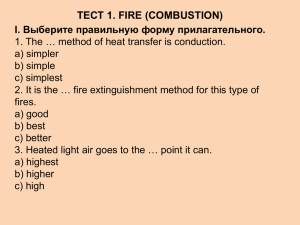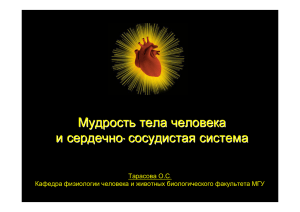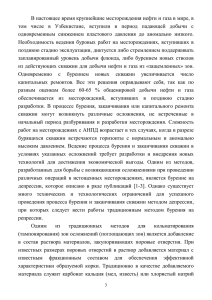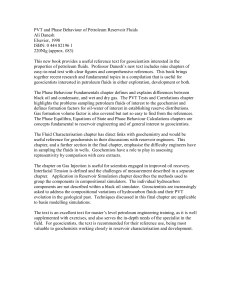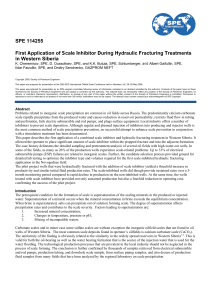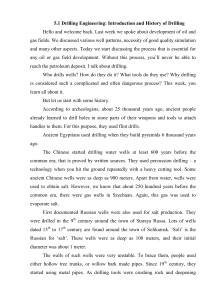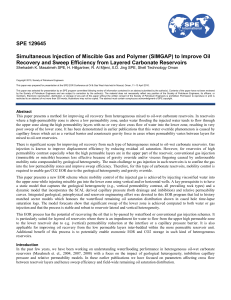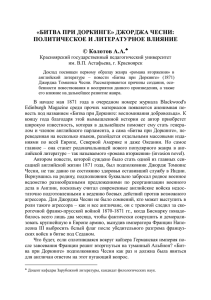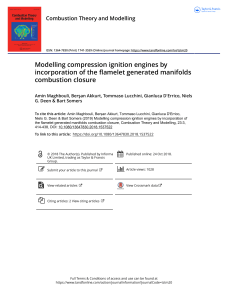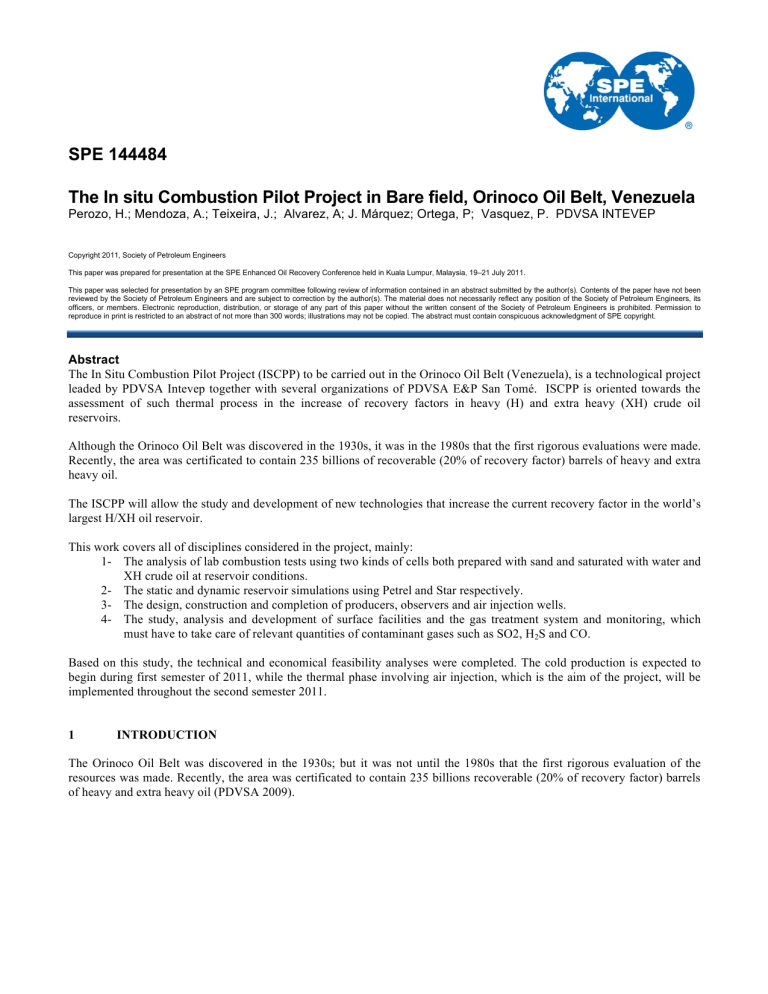
SPE 144484 The In situ Combustion Pilot Project in Bare field, Orinoco Oil Belt, Venezuela Perozo, H.; Mendoza, A.; Teixeira, J.; Alvarez, A; J. Márquez; Ortega, P; Vasquez, P. PDVSA INTEVEP Copyright 2011, Society of Petroleum Engineers This paper was prepared for presentation at the SPE Enhanced Oil Recovery Conference held in Kuala Lumpur, Malaysia, 19–21 July 2011. This paper was selected for presentation by an SPE program committee following review of information contained in an abstract submitted by the author(s). Contents of the paper have not been reviewed by the Society of Petroleum Engineers and are subject to correction by the author(s). The material does not necessarily reflect any position of the Society of Petroleum Engineers, its officers, or members. Electronic reproduction, distribution, or storage of any part of this paper without the written consent of the Society of Petroleum Engineers is prohibited. Permission to reproduce in print is restricted to an abstract of not more than 300 words; illustrations may not be copied. The abstract must contain conspicuous acknowledgment of SPE copyright. Abstract The In Situ Combustion Pilot Project (ISCPP) to be carried out in the Orinoco Oil Belt (Venezuela), is a technological project leaded by PDVSA Intevep together with several organizations of PDVSA E&P San Tomé. ISCPP is oriented towards the assessment of such thermal process in the increase of recovery factors in heavy (H) and extra heavy (XH) crude oil reservoirs. Although the Orinoco Oil Belt was discovered in the 1930s, it was in the 1980s that the first rigorous evaluations were made. Recently, the area was certificated to contain 235 billions of recoverable (20% of recovery factor) barrels of heavy and extra heavy oil. The ISCPP will allow the study and development of new technologies that increase the current recovery factor in the world’s largest H/XH oil reservoir. This work covers all of disciplines considered in the project, mainly: 1- The analysis of lab combustion tests using two kinds of cells both prepared with sand and saturated with water and XH crude oil at reservoir conditions. 2- The static and dynamic reservoir simulations using Petrel and Star respectively. 3- The design, construction and completion of producers, observers and air injection wells. 4- The study, analysis and development of surface facilities and the gas treatment system and monitoring, which must have to take care of relevant quantities of contaminant gases such as SO2, H2S and CO. Based on this study, the technical and economical feasibility analyses were completed. The cold production is expected to begin during first semester of 2011, while the thermal phase involving air injection, which is the aim of the project, will be implemented throughout the second semester 2011. 1 INTRODUCTION The Orinoco Oil Belt was discovered in the 1930s; but it was not until the 1980s that the first rigorous evaluation of the resources was made. Recently, the area was certificated to contain 235 billions recoverable (20% of recovery factor) barrels of heavy and extra heavy oil (PDVSA 2009). 2 SPE 144484 Orinoco Oil Belt 2 Total Area: 55.314 Km Orinoco Oil Belt 2 Exploited Area: 11.593 Km Figure 1. Orinoco Oil Belt Division. The efficient exploitation of the large heavy and extra heavy oil reserves contained in the Orinoco Oil Belt must be linked to a substantial reduction of the production, transportation and refining costs in order to maintain the competitiveness on their marketing. Every day, the production of heavy and extra heavy oils gains relevance, mainly because the depletion of the light oil reservoirs which are currently being used as natural solvents during the extraction of the heavy ones. The best heavy and extra heavy oil reservoirs are found on the eastern side of Venezuela, specifically in the Orinoco Oil Belt. For the production of these reservoirs it is necessary to implement secondary and/or tertiary recovery methods in order to increase oil mobility making easier its extraction. Due to the high viscosity, the exploitation of heavy and extra heavy oils in Venezuela has been limited to the use of the Cyclic Steam Injection method. Nevertheless, in past years some in-situ combustion projects were developed, proving this is a viable method for the Venezuelan reservoirs. One of the reasons this method has not maintained in use is due to the high complexity. This is the why it is necessary to maintain a continuous development and investigation in this area. These studies, in addition to the development of a detailed reservoir model, are the key to the success of these non-traditional technologies. A field pilot test will be implemented in order to study the process described above, for which it is required laboratory test, static model, reservoir dynamic simulation, design of the down hole and surface units, and a thorough study of the environmental impact and control to ensure the safe operation of the pilot test at the lowest cost. This process comprises the injection of air into the reservoir, which will be done through the injector wells. The oxygen in the air oxidizes the crude generating heat, carbon monoxide, carbon dioxide, oxygenated hydrocarbons and water. Depending on the reactivity of the oil and the conditions of the reservoir, the oxidization reactions at low temperature may promote the ignition of the oil. During a combustion process, the combustion front moves forward partially burning the crude from the injector well, where the combustion occurs, to the producer wells. The heat generated by the exothermic reaction lowers the viscosity of the crude close to the combustion front. The heated crude, which has a better mobility, is conducted before the combustion front to the producer wells by the combustion gases. A portion of the crude, non-volatile and with low-mobility, remains as a residue which is used as fuel in the advancement of the combustion front. The process on the surface comprises the following steps: (1) Injection of the ignition fluid and alternate ignition systems (2) Compression, handling and injection of the air required for the oxidation reactions (3) Installation for the production methods (4) Surface installations for the handling, separation and treatment of the gas and the pumping of production to a storage tank or to a flow station. All the way through the development of this project valuable information will be gathered. This information will serve as a basis for the planning of future combustion projects under different well arrangements, different level of energy into the reservoirs and different thermal displacement processes at long and short distance. Furthermore, this information will be valuable when this technology gets implemented in a massive way allowing the acquirement of the information regarding the increase of the recovery factor in the reservoirs of the Orinoco Oil Belt, currently with a value (under cold production) less than 6% due to the high viscosity of the oil. The in-situ combustion technology is art of the enhanced oil recovery methods available to the optimal exploitation of the Orinoco Oil Belt. SPE 144484 2 3 IN-SITU COMBUSTIÓN The In-situ Combustion technology with thermal displacement is an enhanced oil recovery process which consists on burning a portion of the oil contained into the reservoir in order to generate thermal energy that allows the increment of the displacement and production of the oil, until reaching recovery factor values over 20%. A portion of the oil contained in the reservoir is used to generate heat into the formation through air injection. When ignition occurs, the heavy fractions of the crude burn and generate heat transfer and the reduction of the viscosity of the oil next to the combustion front. The crude mobilized by this thermal scanning is pushed toward the drainage points located hundreds of meters from the injection well (Figure 1). Figure 2. Thermal displacement by in-situ Combustion 2.1 Key Mechanisms for the In-situ Combustion Process The most important mechanisms that take place in a in-situ combustion process with thermal displacement are: The combustion zone (oxidation zone) acts as a piston that consumes (burns) and displaces the fluids located in front of the combustion front towards the producer wells. During the in-situ combustion process, the oxygen is combined with the fuel (coke) forming carbon dioxide and water, generating heat. The petroleum composition affects the amount of heat generated. The combustion reaction is maintained through the injection of air. The thermal cracking causes the deposition of fuel (coke) in the front and generates an enhancement of the crude down hole. The combustion gases vaporize the existing water. The temperature range is between 1000 and 1400 °F. When a stabilized dry combustion front is obtained, there is the possibility of injecting water with the purpose of using the high temperature of the sand that has been burned by the front and take advantage of the high specific heat of the water, improving the efficiency of the oil sweep (Wet Combustion) The gravitational drainage is utilized. 2.2 Application Criteria of the In-Situ Combustion technology The range of application of this technology is very wide when considering medium, heavy and extra heavy oils. The most important variables in the selection of the reservoirs in which the technology is going to be implemented are: 1. 2. 3. Depth Thickness Viscosity 200’ – 11400’ 10’ – 200’ < 30000 cps 4 SPE 144484 4. Permeability > 100 mD 5. Porosity > 28% 6. Swi 0 - 35% 7. The temperature is no critical 8. The pressure inside the reservoir when the process begins, does not affect its efficiency, 40 – 5100 lpc 9. The existance of free gas is harmful. Crude with high percentage of heavy components. 3 LOCATION. The in-situ combustion project will be developed in Bare (San Tome) located in the Orinoco Oil Belt, The area in Bare is located in Anzoátegui state, approximately 40 Km. south of the city of El Tigre and about 70 Km. north of the Orinoco River. This area covers 487 Km2 with a length of 27 Km. and a width of 18 Km approximately. This area is located in the northwest sector of the Ayacucho area, in the Orinoco Oil Belt, presenting an east-west course. This area limits with the fields Miga and Yopales Sur to the north, with the Huyapari area to the south, with the Cariña and Iripa areas to the east and with the Arecuna area to the west (Figure 3) Traditional Area Figure 3. Location of the Bare area 4. LABORATORY TESTS IN COMBUSTION TUBES Laboratory tests in combustion tubes were carried out in the laboratories of PDVSA Intevep and in ONGC India, these tests were considered very important in the design and planning of the in-situ combustion project in the Bare field. The data obtained is shown below: Reaction kinetic Creation, maintenance and propagation of the combustion front Evaluation of the design parameters for the laboratory test and surface facilities. Air requirement Coke accumulation Wet combustion analysis Maximum Temperature Recovery factor SPE 144484 5 Crude enhancement Combustion gases analysis The results obtained by Intevep and India in the combustion tubes were corroborated. The tests were carried out with the same fluids and sand. The combustion tube in the Indian laboratory is six times longer than the one used by Intevep, the results are shown in Table 1. PDVSA 570 °C (1058 °F) 3 260 - 400 m air / m3rock 23 - 34 kg combust. / m3 81% Maximum Temperature Air Requirement Combustible Array N2 Concentration CO Concentration CO2 Concentration O2 Concentration H2S Concentration (*) 14 - 16 % 2% 0,5 - 2,7 % 0 - 855 ppm 0,7 - 1 Molar Ratio ONGC IRS (India) 613 °C (1135 °F) 3 3 170 - 400 m air / m rock 15 - 35 kg combust. / m3 83% 13 - 15 % No Measured by the Instrument 0 - 2% 0 - 200 ppm 1,8 - 2,7 (*) Dry Combustion Table 1. Results obtained in the combustion cell by Intevep and ONGC Lab in Intevep 6% Lab in India 9% 8% 10% 85% 82% Produced Not recovered Consume Figure 4. Crude´s Global Balance of the tests at Intevep and ONGC RESERVOIR CHARACTERIZATION Information of the recently drilled wells was acquired, as well as, information of the conventional and especial analysis of the three cores taken from the wells MFB-788, MFB-818 and MFB-819. Once the information was gathered, the model in Petrel was updated as follows: • Besides the model data obtained in Roxar, the information regarding the proposed new wells was entered in Petrel with its petro-physical interpretation (obtained using Golog from Paradigm) • The quality control of every piece of data obtained from Roxar’s static model was carried out. The main reason for this is that there were some differences in the depth values between the marks and the generated surfaces, erroneous data in the deviations, horizontal wells without the deviation information, surfaces with point out of the range, among others. The validation methodology was the following: • The basic data of the wells in Petrel was compared to the one found in the digital data files from the well registers (tiff files) and with the E&P database (Finder). 6 SPE 144484 • • • The deviations loaded in the project were verified with the deviations found in the tiff files and with the ones found in Finder. The depths of the tops of the formations loaded (markers) were compared to those that appear on the tiff files and with the correlation made in Open Works. The amount of holes for each well was verified, as well as which of them The quality control of the data was very helpful to select the information to use for the updating of the Petrel Model. 5.1 Reservoir Selection The following parameters were analyzed for the selection of the reservoir: • Wells and trajectories • Well registers (LAS files) • Markers (top and base of the R0 sand, Oficina formation) • Structural contours • Fault polygon 5.2 Facies Interpretation and y Petrophysics The quality control of the facies interpretation was carried out by petrophysics, in order to identify zones or intervals where some consistency between the petrophysics and the facies were present. The values (codes) assigned to the different facies, defined by the sedimentological interpreter and displayed in templates. The limiting values (cutting parameters) established by the petrophysical interpretation were: Irreducible water saturation (Swir): 12%, clay content (VSH) <= 40%, porosity >= 10%, water saturation (Sw) <= 50% and permeability (k) > 250 mD. 5.3 3D Static Model. Estructural Model In order to establish the structural model of the project, the model made in San Tomé was used, working with the seismic cube that belongs to the south area of Bare Field and with the seismic cube that belongs to the North of the Huyapari Field. The project area is 59 Km2. Figure 24 shows the 5x5 line seismic grid, interpreted in both field, of the GC6_125_merge-t horizon. The white polygon is the limit of the area in study. In this area, there are 15 wells which are shown in Figure 5. BARE CAMPOS BARE Y HUYAPARI Campos Bare y Huyapari MFB423 MFB052 HUYAPARI MFB014 MFB528 MFB646 MFH004 B3-CO3 B3-CO1 MFH008 C3-CO1 D2-CO2 MFH018 Figure 5. Seismic grid interpreted in the GC6_125 horizon B4-CO3 C3-CO2 D3-CO2 SPE 144484 7 The seismic data are generally of good quality. The size of the cell is of 30x30 m in the Huyapari and 12.5x12.5 m in Bare. In the Huyapari almost all of the wells have verification shots and synthetic seismograms with a very good seismic calibration. AS it was mentioned before, the area of the R0 MFB52 reservoir can be found delimited by two medium normal faults, with an average vertical separation of 50 feets at basement level and less than 50 feets in the R0 sand. The result of the data revision was to generate a polygon of faults to the R0 sand, in the area of the R0 MFB-52 reservoir from Bare field. 6 COMBUSTION DYNAMIC SIMULATION IN THE RESERVOIR The numeric simulation of the combustion process was carried out considering two stages: laboratory and field. In the first stage, the results from the laboratory tests, obtained with the combustion tube at Intevep, were loaded in the Stars simulator in order to adjust the numerical equations that describe the physical behavior of the combustion process. Meanwhile, during the second stage the historical setting of the wells was considered to simulate the dynamic behavior of the reservoir during cold production and to count with a robust model that allows predicting the production behavior using the combustion process as close as possible to actual behavior. Also, in this stage the different well arrangements were evaluated, making it possible to select the most suitable for the reservoir exploitation. 6.1 Simulation of the laboratory test with combustion tubes. The simulation of a laboratory test with a combustion tube was carried out in order to ensure obtaining accurate predictions of field-scale simulations and to demonstrate that the numeric model is capable of giving the same results as the actual test.In this way, the simulations at field-scale are going to be discussed in the following chapters. 6.2 Well arrangement analyzed in the simulation. Premises The premises analyzed for the selection of the well arrangement (figure 6) most suitable to the rock characteristics and the fluids that exist in the reservoir R0 MFB-52, are: • Control and efficient monitoring of the progress of the combustion front • Higher sweep efficiency • Short-term results • Production increase • Recovery factor increase • A well configuration that can be extrapolated to other areas of the reservoir • Combustion front stability Longer productive life of the wells Producer Injector Observer Arrangement 1 Arrangement 3 Arrangement 2 Arrangement 4 Figure 6. Arrangements evaluated through the dynamic simulation 8 SPE 144484 6.3 Selection of the optimal well One of the selection criteria for the optimal arrangement was the recovery factor reached by the combustion process in each of the well configurations. The calculation of this value was made on the area affected by the combustion and for this the temperature was selected as the indicator parameter of the affected area, whether it is based on the progress of the combustion front or on the gases generated by this process (Table 2). This means that the recovery factor was calculated for the reservoir sector where the temperature at the end of the prediction (4 years) is higher than the initial temperature of the reservoir. POES ARRANGO Np cold Np ISC RatioNp (MMBN) (MMBN) (MMBN) (MMBN) 1 1.21493 0.600000 1.24497 0.64497 0.53 2 1.81122 0.417515 1.30904 0.891525 0.49 3 2.50696 0.250302 1.08834 0.838038 0.33 4 3.83912 0.102573 1.26352 1.160947 0.30 FR Accumulative Oil (4 Years) RF RF = (Np extra)/POES Table 2. Recovery factor calculation for oil accumulated Another criteria used to select the optimal arrangement was the time of response in the producer wells of every arrangement. It was established as time of response as the period between the beginning of the air injection and the date on which there is a production increase on the gas and oil coming from the producer wells. These results were used to select the optimal arrangement, giving a greater importance to the recovery factor values and to the time of response in the producer wells. Producer Injector Observer Figure 7. Well arrangement for the ISC pilot test SPE 144484 9 6.4 Air injection rate The air injection rate was evaluated at different flow rates (3.5, 4 and 6 mm scf/d), indicating that there is a proportional relation between the injected air and the recovery obtained. Nevertheless, it is not convenient injecting at high rates from the beginning of the project, because the penetration of the gases accelerates toward the producer wells, leaving oil which is not swept by the gases behind. Besides, it was evaluated the combustion process a different air injection rates. For this evaluation the first flow rate used was 4.2 mm scf/d, until a value of 5 mm scf/d was reached in a period of 120 days On table 3, the results obtained for each case are shown. Air Rate (MMSCF/D) 3.50 4.00 6.00 Variable (0.042 – 5.00) Response Time 1 year and 7 months 1 year 3 months 7 months Table 3. Evaluation of the ISC process at different flow rates According to the evaluation of the operational parameters, the distance between the injection and the producer well and the injection flow rate of air, for the beginning of the test, the process must be operated with a variable injection flow rate and a 100 m distance between the injection and producer well. 6.5. Location of the observation wells The location of the observation wells was evaluated in order to determine the evolution of the progress of the combustion front during the field test using these wells. For that, it was considered that the zone affected by the temperature was the most suitable to analyze the progress of the combustion front throughout the time (figure 8), considering the increase of the values of temperature shown by the reservoir simulation. Figure 9 shows the final location of the ISC well arrangement obtained by numeric simulation. Area Affected by Temperature Figure 8. Zone Affected by the temperature every 100 m 10 SPE 144484 Figure 9. Final location of the ISC arrangement obtained by numeric simulation WELLS CONSTRUCTION Based on the results obtained in the study, a drilling strategy was design to minimize the geological uncertainty, to validate the current models, in a way that guaranties the success of the in-situ combustion pilot project on the R0 MFB-52 reservoir of the Bare field. Two horizontal wells were drilled, and there will be installed sensors to measure the pressure and temperature at some points, and optical fiber to measure the temperature profile. After that, it is going to be drilled the air injection well and four vertical wells which will be used as observers. Each of these wells will be instrumented with pressure and temperature sensors down hole.. 7.1. Well Completion The well architecture that forms the selected arrangement was design with the purpose of having a mechanical configuration appropriated to the expected temperature and pressure conditions, as well as to the presence of H2S and CO2. The production string for the horizontal production wells was designed to bear high temperatures, corrosive environments and to handle the expected production flow rates. The continuous monitoring system of temperature and pressure in the injection well, in the production wells and in the observation wells, will allow analyzing the real-time readings of temperature, pressure and flow rates in the surface. Vertical Section Well Cutting 1 Casing 9-5/8” 2 Tubing 5-1/2” 3 Flex Pipe1-1/2” 4 Capilaries 1/8” and !” 5 Flex Pipe 1-1/4”to diluent injection 6Capilaries 1/8” T and P Sensors Horizontal Section Pressure Figure 10. Production well completion Pressure SPE 144484 11 5 1/2” FOX x 17 #/Ft, L-80, AIR INYECTION TUBING. 1/8” - 1/4” CAPILLARY LINES FOR TEMPERATURE AND PRESSURE SENSORS. 13 3/8” BTTS x 68 #/Ft, N-80 CASING @ +/- 1.000’. 2 3/8” HYD-511 x 4,7 #/Ft, L-80 STEAM INYECTION TUBING. TEMPERATURE SENSOR. PRESSURE SENSOR. 9 5/8” x 7” x 43,5-23 #/Ft x 6” I.D THERMAL LINER HANGER WHIT PBR @ +/- 2.610´. HIGH TEMPERATURE SEALS ASSY. 7” BTTS x 23 #/Ft x 42’, L-80 BLANK PIPE. TEMPERATURE SENSORS 1/4” CAPILLARY LINE FOR TEMPERATURE AND PRESSURE SENSORS. PRESSURE SENSOR. 7” BTTS x 23 #/Ft x 0,012” x 42’, L-80. THERMAL SCREENS RO (2.694’-2.728’) INYECTION INTERVAL 7” BTTS x 23 #/Ft, N-80 SHOE @ +/- 2.752’. 9 5/8” BTTS x 43,5 #/Ft, N-80 CASING @ +/- 2.770’. FINAL DEPTH@ +/- 2.770’. Figure 11. Injection well completion 8 SURFACE FACILITIES The scope of the project comprises the construction of the surface required to the transfer of the multiphase flow, the separation, disposition and treatment of the obtained gas, liquid treatment, storage and transfer of the obtained crude during the production and disposal of the water used in the process. The total scope comprises the design of the surface facilities in the injection well, which includes: facilities to interconnect the handling and injection of the ignition fluid (water vapor), compression system, handling and injection of the air, facilities for the interconnection of the water and nitrogen injection, the measurement systems in the observation wells, the facilities associated to the production wells, facilities for the separation and treatment of the gas and oil recovered. It is envisaged the creation of mechanical and electrical facilities for the recovery of the crude in the production wells, and the production facilities for the transportation of the recovered crude towards the ISC discharge station. This station will be comprise by the following equipments: vertical separators, settling tanks, storage tanks for crude, oil pumps to transfer the crude from the storage tanks to the multiport valve, water storage tanks, gas treatment system, venting and chemical dosing (corrosion inhibitor, H2S scavengers and demulsifier) The installation of the equipment is divided in: • • • Installation of the air injection system in the injection well, which involves the air injection line to the well, there will be injected a maximum value 6 MMPCND. The supply of the gas required for the compressor is approximately 0,5 MMPCND. Construction of the surface facilities and the interconnection of the mechanical pumping system in the head of the production wells. Installation of two (02) production separators of the multiphase flow in order to handle the production of gas and liquid (9 MMPCND and 3.450 BPD) 12 SPE 144484 • • • • • • • • Installation of six (06) storage tanks with the objective of allowing the of crude and water, including the interconnection of the storage tanks and the interconnection of the settling tanks with the water transfer pumps towards the water storage tanks. The installation of three (3) storage tanks for the crude, and the interconnection of the tanks. These tanks will receive the dehydrated crude from the separator or from the settling tanks, as well as the construction of the head for the pumping system. Construction of the pumping system of the crude that allows the crude transfer from the storage tanks to the existing multiport valve (MFB-646). This involves the suction and discharge heads of the pumps, drainage of the oily water, protection system, quality and quantity measurement system of the crude in line. Back-up pumps are included. Construction of the water pumping system that allows the transfer of the water from the settling tanks to the water storage tanks. It involves suction and discharge heads of the pumps, protection system, quality and quantity measurement system of the water in line. It includes back-up pumps. Installation of three (03) storage tanks for water, it involves the heads to receive water from the pumping system. Construction of the gas treatment system which will allow the removal of the H2S and the CO, through the thermal oxidation y later neutralization, which consists in one oxidation reactor, one heat exchanger and one neutralization reactor. Construction of the system for the venting and relief of the combustion gases obtained during the separation of the fluid through the pressure vessels, it is consider the monitoring system fort the gas quality and venting system. Construction of the interconnection for the diluent injection, which will be done in the production well head. Installation of the chemistry dosing system, considering the use of three types of chemistry: the corrosion inhibitor, which will be applied in the multiphase fluid at the inlet of the ISC discharge station, H2S scavenger in three injection points: in the multiphase flow at the entrance of the separators, in the clean gas line towards the venting and in the crude line toward the settling and demulsifying tanks, using it exclusively at the entrance of the station. This system comprises the installation of the chemistry storage tanks and the pumping system for the injection considering pumps associated to every type of chemistry. 8.1 Flue gas treatment system There are many Technologies used for the treatment of H2S and CO, such as the use of amines, iron oxides, membrane processes, biological processes, neutralization, among others. However, the majority of these technologies are focused on the treatment of natural gas currents instead of flue gases. Vent Flue Gas From Separator FGD Thermal Oxidizer Fin Fan Cooler Figure 12. Diagram for the flue gas treatment. ISC pilot test, Bare field. In the case of the flue gases expected to be generated during this pilot test, which do no contain hydrocarbons, and besides have traces of hydrogen and oxygen that are not compatible with many of the sweetening technologies, which are limited especially when the H2S content might have variations during the different phases of the pilot test. In that way, the proposed technology for the treatment of the H2S and CO consists on the thermal oxidation of these gases followed by the neutralization of the products of the oxidation (SO2 y CO2) in a basic medium with calcium carbonate (CaCO3). SPE 144484 13 The methodology for the treatment of the H2S and the CO could be present in the gas current of the ISC pilot test, comprised of three stages, which are described bellow: 1. The gas current coming from the gas-liquid separation system with an estimated flow rate of 6 mm scf/d, enter in a furnace at high temperatures (400-600 °C) and is treated through a thermal oxidation process with air in excess, in which the H2S and the CO are transformed in sulfur dioxide (SO2), sulfur trioxide (SO3) and CO2. The efficiency of thjis process is estimated to be close to 9.9%. The following reactions occur in this stage: Hydrogen sulfide oxidation (H2S) 3 # H 2 S + O2 ! SO2 + H 2 O !" 2 # H 2 S + 2O2 ! !" SO3 + H 2 O Carbon monoxide oxidation (CO) 1 # CO + O2 ! !" CO2 2 60°C. 2.- After the thermal oxidation, the temperature of the gas is lowered by a heat exchanger until reaching a value of 3.- The gas enters in a reactor which is bubbled in a CaCO3 solution in order to neutralize the SO2, obtaining as main product calcium sulfate (CaSO4) which is innocuous to the environment. Most of the CO2 in vented to the atmosphere. The reactions that take place in this device are the following: Absortion Oxidation Neutralization Regeneration Precipitation 14 SPE 144484 9 CONTROL AND MONITORING PLAN The implementation of diverse strategies for the control and monitoring are contemplated. As a result from this, important parameters will be evaluated, such as: Production flow rate, air injection rate, down hole temperature (along the horizontal and vertical sections of the production wells, and the temperature on the injection and observation wells), pressure, water cuts, among others, that help in the optimization the rates and period of the air injection process, ensuring the success of the pilot project. The scope of this plan is to establish the necessary orientations and procedures for the evaluation of the critical variables of an enhanced oil recovery pilot project, taking into account that the interpretation and analysis of the obtained results will serve as the basis for a future planning of in-situ combustion projects for a wide variety of oil reservoirs with different levels of depletion and different well arrangements. 10 CONCLUSIONS • • • • • • • 11 The test using cells carried out at Intevep and at ONGC (India) showed excellent results for the application of this technology The long distance in-situ combustion reduces the possibility of air canalization because there is a piston-type displacement, thus there is a sanding risk The well arrangement and the selection of the reservoir in which the technology will be applied allow inducing the orientation of the combustion front towards the horizontal wells used as producers. This flow pattern is the most adequate for the pressure depletion process in this area of high sensibility The thermal oxidation of H2S and CO is a process with efficiency over 99%, corroborated in laboratory tests at high temperatures and the oxygen requirements of the kinetic. The by-products generated in the FGD reactor, carbonate and calcium sulfate are innocuous, easy to handle and represent a resource for the agriculture The by-products generated in the FGD reactor, carbonate and calcium sulfate are innocuous, easy to handle and represent a resource for the agriculture The well arrangement designed and simulated lowers the H2S corrosive effects at high temperatures for the down hole and surface equipments REFERENCES 1. Estudio de Impacto Ambiental y socio cultural Proyecto Piloto de Combustión en Sitio a Larga Distancia (CESLD), Campo Bare, Distrito San Tomé. 2008 2. Greaves, M., Xia, T., and Ayasse, C., “ Underground Upgrading of Heavy Oil Using THAI (Toe- to Heel Air Injection)”, SPE 97728, Presented at the 2005 SPE International Thermal Operations and Heavy oil Symposium held in Calgary, Alberta, Canada, 1-3 November, 2005. 3. Hernández, N., “Evaluación Experimental del Proceso Combustión In Situ Empleando crudo de la Faja Petrolífera del Orinoco”, Trabajo de Grado Presentado a la Facultad de Ingeniería, Universidad Central de Venezuela, 2003. 4. Panait, A., Serban, D., and Ilie, N.,” Suplacu de Barcau Field – A Case History of a Successful In-Situ Combustion Exploitation”, SPE 100346, Presented at the SPE Europec/EAGE Annual Conference And Exhibition Held in Vienna, Austria, 12-15 June, 2006. 5. Pratap, V, RK Sood and B Ram. 2006. IOR strategies in Brownfields of Mehsahna Asset, North Cambay Basin, India. SPE/IADC 102298. pp 1-11. 6. Sarathi, P.S., “Nine decades of combustion oil recovery-a review of in situ combustion history and assessment of geologic environments on project outcome,” Proc. 7th UNITAR International Conference on Heavy Oil and Tar Sand, Beijing, China, 27-30 October, 1189-1200, 1998. 7. Sarathi P. In-Situ Combustion Handbook Principles and Practices. BDM, Petroleum Technologies. Oklahoma, USA. January, 1999. Shioya Y. & Yamamoto K. Cuttings Reinjection to shallow urdersea formation: the geomechanical acceptance analysis using hidraulic fracturing simulator. Society of Petroleoum Engineers. SPE 78586. 2002. 8. 9. Terwilliger, PL; RR Clay; LA Wilson and E González-Gerth. 1975. Fireflood of the P2-3 Sand reservoir in the Miga field of eastern Venezuela. Journal of Petroleum Technology. January 1975. pp.9-14 . SPE 144484 15 10. Turta, A., “Evaluation of IOR Potential of Petroleum Reservoirs”. Institute de Recuperation the Petroleum, Alberta, Canada, 1994. 11. Turta AT and AK Singhai, 2001. Reservoir engineering aspects of light-oil recovery by air injection. SPE 72503. pp 336-344. 12. Wang L; Williford C. and Wei-Yin C.. Desulfurization and Emissions Control. From: Handbook of Environmental Engineering, Volume 2: Advanced Air and Noise Pollution Control. The Humana Press, Inc., Totowa, NJ 2005.
